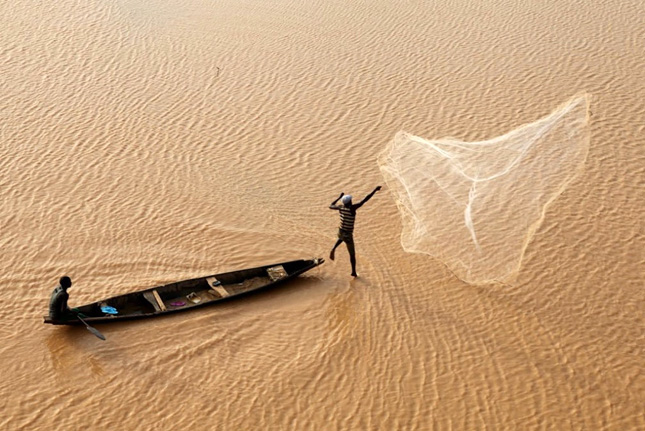-
Calming the Waters: Why We Need to Better Integrate Climate and Water Policy
August 23, 2016 By Sabine Blumstein
The Nile River is shared by 11 countries, for which it is vital for food and energy production, freshwater, and as a means of transportation. Sharing the resources of the Nile has, however, been politically difficult. Recently, the construction of the Grand Ethiopian Renaissance Dam has caused a major dispute with downstream Egypt which fears the dam will affect water flow in its own territory.
Considering that climate change is expected to intensify droughts and other water-related challenges in many international river basins, it is important to build up adaptive capacities now in places like the Nile basin to manage risks, safeguard livelihoods, and prevent conflict.
According to a new report from adelphi, launching at the 2016 World Water Week in Stockholm, transboundary river basins need closer integration of existing instruments provided by the water and climate communities. Water and Climate Diplomacy outlines different water policy tools used in many river basins to support climate change adaptation, but also explains a number of deficiencies. We argue that climate policy instruments could be used to overcome existing shortcomings and strengthen adaptive responses to avoid disputes.
Plugging Into Adaptation Planning
In some river basins, riparian governments are already using climate tools to improve water management and adapt to changes, often at the regional scale.
The Niger basin in West Africa is inhabited by 120 million people across 11 countries, the majority of which are farmers, pastoralists, or fishermen whose lives are closely linked to the river’s waters. The basin’s population is highly impacted by extreme rainfall and flow variability, both of which are likely to be exacerbated by future climate change. Existing competition over natural resources and local conflicts could therefore grow. This could further destabilize a region which is already characterized by high political instability. Under these conditions, adaptation to climate variabilities and anticipated future changes is crucial to ensure poverty alleviation and political stability.
Climate funds could – and arguably should – be used for transboundary water activities as wellIn 1980, nine basin countries formed the Niger Basin Authority (NBA) with the aim of jointly developing water resources and promoting development in the region. In recent years, the NBA has taken a number of steps to address climate change threats. In 2015, the NBA adopted the ambitious Niger Basin Climate Resilience Investment Plan through which it advocates for technical and financial support to implement 246 adaptation-relevant projects and activities.
These and other examples demonstrate that “climate diplomacy” tools, such as national adaptation planning, can make a significant difference strengthening adaptive responses at the transboundary river basin level too. The Niger basin plan includes a diversity of activities, such as the establishment of climate insurance for farmers in Burkina Faso, the adaptation of farming calendars and crops in Benin and anti-erosion activities in Mali, which had previously been identified through national adaptation planning processes.
Linking With Water Policy Instruments
The report calls for the incorporation of climate policy tools into existing water management instruments and stronger integration between the two for three main reasons.
First, national adaptation activities can create unintended negative effects on other riparian nations. Adaptation to climate change is so far primarily happening at the national level where climate policy instruments such as vulnerability assessments and national adaptation plans are already commonly used. However, there are important transnational implications of these efforts. If, for example, an upstream country moves from rain-fed to irrigated agriculture in response to changing climate conditions, it could affect the water supplies of downstream neighbors. Such a scenario could develop on the Nile if Ethiopia faces more droughts as severe as the current one.
Second, stronger coordination between riparian nations could provide benefits. For instance, often flood protection measures are easier and/or more cost-effective if realized in upstream countries. Flood warning and flood protection measures along the Lower Rhine in the Netherlands, for example, would be much more difficult to realize without cooperation with Germany.
In both cases, stronger integration of national climate tools and transboundary water activities could support adaptation in international river basins for the benefit of socioeconomic development and security.
Finally, adaptation to a changing climate will in many cases require additional funding. In recent years the international community has established different funds for climate change mitigation and adaptation to provide necessary resources. While most of these funds to date focus on national adaptation projects, they could – and arguably should – be used to finance transboundary water activities as well.
What can international actors do to support these goals? The report identifies a number of concrete steps that policymakers can take, including setting up new river basin institutions or strengthening existing ones, facilitating access to climate change funds, and increasing links between regional and national levels of river basin management. These activities require stronger support from the international community and those in the climate and water policy communities in particular.
Investing time and resources to strengthen synergies between water and climate diplomacy may be time consuming and require additional resources. Yet, if we want to manage some of the most substantial risks posed by climate change, and ensure peace and stability, such investments are likely to prove worthwhile.
Sabine Blumstein is a project manager at adelphi, an independent think tank and public policy consultancy, focusing on international water cooperation, resource governance, vulnerability, and adaptation to climate change.
Sources: Adelphi.
Photo Credit: Fishing on the Niger River, Niamey, Niger, courtesy of Gert-Jan Stads/IFPRI.
 A Publication of the Stimson Center.
A Publication of the Stimson Center.



